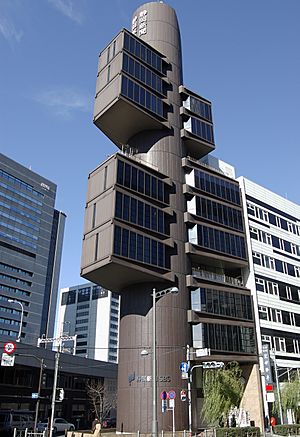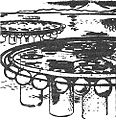Metabolism (architecture) facts for kids
Metabolism was an exciting idea in architecture that began in Japan around 1960. This way of designing buildings and cities was like thinking of them as living things. Just like our bodies change and grow, these architects believed buildings and cities should also be able to change over time.
This idea came about as Japan was rebuilding after World War II. Many cities needed new homes and buildings. The Metabolist group wanted to create flexible designs. They wrote a short book in 1960 called "The proposals for a New Urbanism" to share their ideas.
Contents
Buildings That Grow and Change
The Metabolist architects were very interested in building homes for many people. They often planned very large city designs called megastructures. These were huge structures that could hold many buildings or even entire neighborhoods.
One famous example of a Metabolist building is the Nakagin Capsule Tower in Tokyo. It was designed by Kisho Kurokawa and finished in 1972. This building was made of many small apartment units, like little boxes. Each box, or "capsule," had one round window.
The Nakagin Capsule Tower
The cool thing about the Nakagin Capsule Tower was that these capsules could be added, moved, or even taken away. It was like a "plug-in building." Kurokawa imagined that old capsules could be replaced with newer, better ones over time. This showed the Metabolist idea of buildings that could change and adapt.
However, the Nakagin Capsule Tower eventually faced challenges. The people living there decided to take it down. They plan to build a larger building in its place. Even so, the Nakagin Capsule Tower remains an important example of the Metabolist movement's ideas about flexible and changing architecture.
Who Were the Metabolists?
The Metabolism group included several important architects and designers. Some of the key members were:
- Kiyoshi Awazu
- Noboru Kawazoe
- Kiyonori Kikutake
- Kisho Kurokawa
- Fumihiko Maki
- Masato Otaka
- Kenzō Tange
These thinkers helped shape how people viewed cities and buildings in Japan and around the world. Their ideas about growth and change are still studied today.
Images for kids
-
The Nakagin Capsule Tower in Tokyo displays small apartment units (capsules) attached to a central building core
-
Kikutake used a photo of Marina City to illustrate the idea of capsules plugged onto a central tower.
-
The Tokyo Bay Plan, a large project by Kenzō Tange from 1960.
See also
 In Spanish: Movimiento metabolista para niños
In Spanish: Movimiento metabolista para niños

















